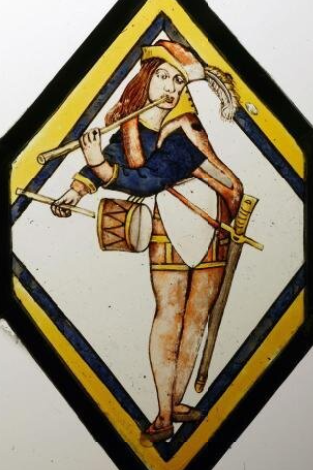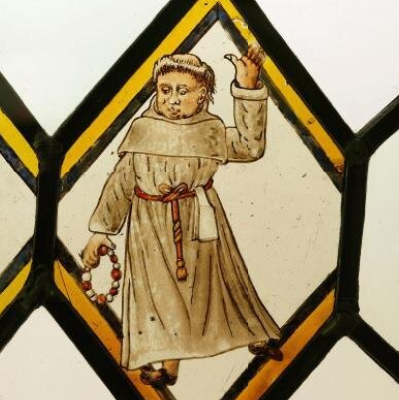Dancing the Morris in the Shropshire Hills. A Whitsun Tale
And let us do it with no show of fear
No, with no more than if we heard England were busied with a Whitsun morris dance
Henry V II. iv. Shakespeare c 1599

This ‘Whitsun tale’ took place on a remote hill in South Shropshire over four hundred years ago. Before we get into the whys and wherefores of the story (of which there are actually very few) it may be helpful to clarify a couple of points.
First, the morris is an early form of English dance, performed in front of an audience. It is a step dance with ‘highly developed foot, hand and body movements’, which developed regional variations. In the 1800’s morris dancing went into a steady decline until its revival early in the 20th century. Certain folkloric figures such as Friar Tuck, Robin Hood, a fool, a knight, have featured since medieval times and can still be encountered in modern performances.
Secondly, Whitsun is the commemoration of Pentecost when the disciples of Christ received the Holy Spirit. It occurs on the seventh Sunday following Easter. How Pentecost acquired the name of Whitsun is unclear. One suggestion is that ‘whit’ comes from the ‘white’ baptismal gowns worn at this time of year. Alternatively, Shropshire’s own John Mirk, the 15th century Augustinian canon, writes
Goode men and woymen, as ȝe knowen wele all, þys day ys called Whitsonday, for bycause þat þe Holy Gost as þys day broȝt wyt and wysdome ynto all Cristes dyscyples
The celebration of the Pentecost was a favourite holiday throughout England often celebrated with great gusto and enthusiasm!.

Clee St Margaret, Shropshire, May 1619
James I (IV Scotland) is king and the country now officially Protestant. Plague, witch trials and land enclosure continue and war in Europe puts pressure upon the Government. Meantime, in the Clee Hills of Shropshire, rents are up, hard days and holidays come and go with the latter providing respite from the daily grind. Yet Whitsun did not quite go to plan in the year 1619 for some folk living in a little village on Brown Clee, the highest hill in Shropshire.
Brown Clee is a large sprawling hill that even today is not easy to navigate. Many old paths, greenways, holloways and drovers tracks, criss-cross streams and valleys, some leading to the village in question, Clee St Margaret, a modest settlement on the upland commons.

Whitsun ales and dancing were popular forms of entertainment during Whitsuntide, a whole week of games and music. Although travelling minstrels and players toured towns and major habitations remote areas often made their own entertainment.
Historical documents record how, in 1619, certain ‘divers’ decided to ‘borrow’ the communion cloth from a neighbouring church to wave as flag during the morris dance at Clee St Margaret. Communion cloths, or ‘carpets’ as they were known, were important and required by canon law to celebrate the morning service. They were usually made from silk or linen. How the men thought they would get away with ‘borrowing’ one is anyone’s guess and they didn’t. Later that year as many as twenty faced a court hearing and it is from the court records that we can glean something of what happened back on that summer’s day.
Ludlow, Shropshire, 12th October 1619
On the 12th October 1619, the Ludlow Deanery court saw proceedings commence against one Nicholas Millichap on the charge of
‘using the communion cloath of Abdon for a flagge in a morrice daunce’.
The following day, the Wenlock Deanery court heard proceedings commence against Thomas Chelmicke on the grounds that
‘…that the communion cloath was lent to make a flagge for a morrice dance…That one Nicholas Mylychap of the parishe of Saint Margarets Clea (as they heard) did borrow the said cloathe, and that one Thomas Chellmicke of Abdon did take the said cloathe out of the said churche of Abdon profaning the same by using it as a flagg in a morrice dance…‘

According to the court records (with varying degrees of confirmation and denial from the defendants) Nicholas Millichap and Thomas Chelmicke had gone to the village of Abdon to fetch the communion cloth from the church to use as a flag for the morris dance. Thomas took the church key from the parson, Mr Tasker, later returning to the parson’s house where Nicholas was waiting in the company of the parson’s wife, her mother and the maid. (I would love to know how complicit these women were in all this and how excited they were, if at all, at the prospect of the dancing and fun down in the village? Maybe they were outraged, powerless to stop it? We will never know). Anyway, it is recorded that Nicholas took the cloth down to Clee St Margaret apparently without Mr Tasker’s consent where it was used in the dancing.
Why they didn’t use the communion cloth from Clee St Margaret’s church is not clear. Maybe they didn’t dare or maybe there wasn’t one. Nevertheless, someone reported this defamation of a holy cloth! At least twenty men were sent for, including the parson and church warden. This was a long and complex case, made more so because although the accused lived in neighbouring settlements, ancient and complex boundaries drawn up centuries earlier meant they lived in two different deaneries, either Wenlock or Ludlow. With such complexities of administration, the numbers of accused and the regular non-attendance at hearings, it took eighteen months to conclude!
The following men are recorded as having key roles in the morris. This information gives us a useful historical insight: we know there was a drummer to keep time and there was a friar and a fool. Intriguingly there was a Lords Shepherd, a character not usually seen at a morris. Historians wonder whether this was a unique regional custom.

Thomas Chelmicke
Tom lived at Abdon village above Clee St Margaret. He was accused of taking the cloth from Abdon church at the instigation of Nicholas Millichop. He was one of the morris dancers who danced with the cloth. Tom was uncompliant and refused to take an oath to speak the truth and recorded as being ‘wilfully disobedient’. He was excommunicated but this was lifted later when he complied with proceedings. In one of the margins it is written that Tom died before the case concluded.

Adam Wilding – drummer
Adam did not turn up to the first hearing. He later denied he knew the cloth was used for communion and that he did not consent to its use. He was let off with a warning. In another unrelated case Adam was incited ‘for incontinency with his future wife’.
William Poulter – Lord’s Shepherd
The role of Lord’s Shepherd is unknown outside the county as far as I am aware. William, a servant, was dismissed with a warning.
Nicholas Reignoldes – the friar.
Nicholas may be the same Nicholas Raynoldes who appeared in court on another occasion for ‘Sabbath breaking’ at nearby Wheathill.

John Botterell
John was charged with carrying a sword in a dance between morning and evening prayer on a Sunday. Did he usually carry a sword or was he performing as a ‘knight’?
Nicholas Millichop & Walter Millichop – the fool
Nicholas and Walter, both from Clee St Margaret, admitted that they danced in the morris with the flag. Walter denied all involvement in the procurement of the flag but agreed that he did dance before it and knew what it was for, as did the other men. Both were dismissed after being given a penance. They may have been related to Edward and William Millichop of The Heath, also implicated in the dance.
Richard Endlicke – hobby horse
Ricard did not appear at one of the hearings in July 1620 and was also excommunicated. He was later dismissed following the completion of his penance.
John Tasker – the cleric/parson
John Tasker was married with a daughter. He denied all knowledge that the flag was to be used in the morris. Tasker was called to appear at Hereford Cathedral in front of the lord vicar general. Hereford is at least a sixty mile round trip, no mean journey for a country parson but he made it there and told the lord vicar general that he would not have lent the cloth if he had known what they wanted it for. I wonder what he thought they were going to do with it?
Other hearings were held down at Ludlow some ten miles away from Brown Clee at St Lawrence’s church and at the Angel Inn where, two hundred years later, Nelson addressed the town after his victory at the Battle of the Nile. The Angel continues today as a hostelry serving excellent food and drink.
It seems the men were eventually dismissed after various penances and admonishments with threats of excommunication for non-attendance. We know no more about the Whitsun gathering and must be grateful for this rare insight of 17th century life in a remote part of rural England.
It is noteworthy that the celebrations went on for seven days covering the whole week of Whitsuntide, so quite an occasion! We may assume there was some organisation of dancers with at least one musician, Adam Wilding. We do not know where it was held: perhaps on the common or in the church yard of St Margaret’s church. The only women mentioned are identified not by name but by position: wife, mother in law and the maid servant.

We are indebted to these men of Brown Clee, these ‘wrong doers’ who put us in touch with this time of celebration in the Clee Hills. I can imagine Richard Endlicke prancing about as a hobby horse, the singing, the outrage at the abused communion cloth!
There were other, similar cases in the locality bought before the court for dancing on the Sabbath, disrupting church services and playing musical instruments in church, some involving women. In the same year as the Clee St Margaret incident a morris dance in Shrewsbury resulted in violence and blood shed !
We must assume that most community gatherings were peaceful and good natured and so did not find their way into the records. Lets hope the people continued to enjoy their seasonal celebrations of life because soon great forces will change everything for the villagers on Brown Clee in the South Shropshire hills.

Records of Early English Drama, Shropshire, vol I & II.
Ronald Hutton, The Stations of the Sun (1996)
Mirk’s Festival: A Collection of Homilies, c1403
